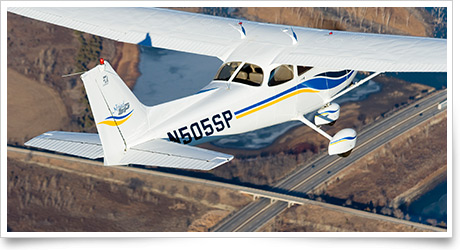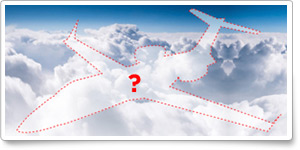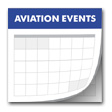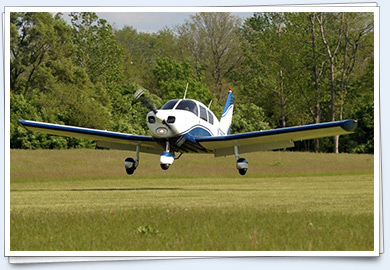Training Tips
Report the road
 The cross-country phase is an exciting stage of flight training that pushes back the boundaries of your aviation universe, builds your endurance, and offers a taste of your aircraft’s capabilities as a traveling machine. Flights to varied destinations expose you to quiet strips or buzzing terminals—and may take you through numerous airspace classes. (For operations in Class B airspace and at airports located within Class B airspace, make sure you meet the requirements and possess required endorsements.) The cross-country phase is an exciting stage of flight training that pushes back the boundaries of your aviation universe, builds your endurance, and offers a taste of your aircraft’s capabilities as a traveling machine. Flights to varied destinations expose you to quiet strips or buzzing terminals—and may take you through numerous airspace classes. (For operations in Class B airspace and at airports located within Class B airspace, make sure you meet the requirements and possess required endorsements.)
Keep in mind that using pilotage to fly in urban environments can present different challenges than selecting and locating checkpoints did on other cross-countries. And because the communications component of flights into busy airspace takes on critical importance now, you may have to locate the proper checkpoint and then report your position as precisely as possible.
That will take great skill and care, with all those buildings, railroads, highways, and interchanges down there. Suppose you are approaching your destination from the west and have been instructed to report at 10 miles west when over a specific highway. Can you tell the many roads apart as they weave their way through the urban sprawl?
One pilot who misinterpreted an assigned reporting point—an error that resulted in an airspace incursion—concluded that “being relatively new to the area and unfamiliar with the terrain and landmarks” contributed to the error, the pilot said in a report to the Aviation Safety Reporting System (ASRS).
What about weather conditions? A pilot noted the contrasting presentations of a chart and the view from the cockpit in this August 2003 Flight Training magazine article:
“The haze rendered many details shown on the sectional chart difficult to pick up until we were relatively close. And, much of the detail that was visible through the haze was not depicted on the sectional chart. For example, there were many more roads than were shown on the chart.”
Studying aerial images and photos beforehand revealed “the true shape of the town, individual streets, identifiable buildings, parks, and baseball fields.”
Chapter 15 of the Pilot’s Handbook of Aeronautical Knowledge provides general guidance for selecting checkpoints, and introduces the technique called bracketing to keep you from straying from the desired track.
“If possible, select features that make useful boundaries or brackets on each side of the course, such as highways, rivers, railroads, and mountains,” it says.
Flight Training News
Cirrus joins workforce-development partnership
A state-funded workforce development program in Minnesota may provide up to 60 employment opportunities at Cirrus Aircraft, where meeting production demands will require more assembly workers, the company said in a news release. Duluth, Minn.-based Cirrus announced a partnership with Lake Superior College to develop an aircraft assembly pre-employment program designed to prepare low-income applicants for assemblers’ jobs at the manufacturer of all-composite aircraft. Read more >>
FAA to release easier-to-read notams
The FAA Safety Team is advising pilots of several changes to the format of notices to airmen and the contractions used in notams. The revisions, which take effect Oct. 1, were “designed to harmonize the U.S. system” with International Civil Aviation Organization (ICAO) standards “and make notams more easily read,” the FAA said. Read more >>
AOPA members share must-have apps
Look up aircraft tail numbers, turn on your aircraft’s preheater remotely, check METARs and TAFs in their raw or easy-to-read format, and zip through Electronic Advance Passenger Information System with these “must have” apps recommended by AOPA members. Read more >>
George Mason University starts flight training program
Northern Virginia’s George Mason University has expanded its offerings to include an aviation minor. Read more >>
NJ aviation program expands to handle worker expansion
The aviation program at Paramus, N.J.-based Bergen Community College has added a full-time professor and chief pilot to help train students for aviation jobs, reports NJ.com. The college offers associate's degrees in aviation administration or aircraft operations.
Speaking with Kentucky’s next generation of pilots
GlobalAir.com’s Ray Robinson had the chance to speak with three student pilots participating in the Kentucky Institute for Aerospace Education (KIAE), reports General Aviation News. KIAE works with 14 high schools in the state to provide students direct experiences in aeronautical engineering, flight, aircraft maintenance, and space systems. The three students were interviewed right before riding with a gathering of Yakovlevs at Bowman Field in Louisville, Ky.
Making that judgment call
One of the toughest things for pilots of any experience level is determining whether the cloud levels and visibility conditions are safe for flight. It can take quite a bit of familiarity with the weather and its trends to make the call. Get a heads-up on this aspect of flight by taking the Air Safety Institute’s Weather Wise: Ceiling and Visibility online course. Log in to take the course >>
More than mere words
Written with the safety of you and your passengers in mind, the federal aviation regulations (FARs) are not just a good idea to follow—they are the law. But that giant book can be a daunting task to read, so the Air Safety Institute has narrowed it down to some of the key points relevant to you. Learn more about the FARs by reading the Air Safety Institute's Federal Aviation Regulations Safety Advisor. Download the PDF >>
Training Resources
 Bird strike Bird strike
It was a nice VFR day—not a cloud in the sky—as the twin climbed out of the pattern at Casa Grande, Ariz. The pilot was settling down on the last leg of a long cross-country flight from Bartow, Fla., to Camarillo, Calif., when he noticed the birds. Experience the pilot coming eye to eye with a four-pound red-tailed hawk and how he dealt with the ensuing mayhem his uninvited feathered passenger caused in the Air Safety Institute’s Real Pilot Story: Bird Strike. Watch the reenactment >>
Did you know that student pilots who join AOPA are three times more likely to complete their flight training? Membership includes unlimited access to aviation information by phone (800/USA-AOPA, weekdays from 8:30 a.m. to 8 p.m. Eastern time) or from Flight Training Online or AOPA Online. If you’re not already a member, join today and get the pilot’s edge.

Icy expedition, blood pressure control
Cessna goes on the attack with its secret Scorpion; aircraft searches get mainstream media attention; and two very long cross-countries: an Arctic expedition and a trip around the world. Also, the doctor is in on AOPA Live This Week®, Sept. 19.
Career Pilot
Former Air Force pilot calls new FAA requirements misguided
Jeff Schneider, a former U.S. Air Force pilot with more than 1,700 hours in the F-16 who also holds an air transport pilot certificate and multiple instructor ratings, writes that there is no rationale to the contention that a lack of flight time among pilots at regional carriers was leading to an unacceptable decrease in airline safety. In a viewpoint in Aviation Week, he argues that an analysis of 40 NTSB accident reports from 1991 to 2012 showed no direct correlation between a single individual’s inexperience and overall safety of the aircraft. Instead, it was the combination of flight-crew experience that correlated with fatal accidents.
United, Continental pilots release integrated seniority list
A three-member arbitration panel has released its opinion on establishing the integrated seniority list for the pilots of United and Continental Airlines. The next and final step will be merging Air Line Pilots Association governance for the two pilot groups in a new United Master Executive Council (MEC), accompanied by an election of four new MEC officers, expected to be completed in October. The combined pilot group will have more than 12,000 pilots.
For more aviation career news, see the Flight Training website.
Plane Spotter
Future Falcon
 When a new aircraft arrives on the scene, plane spotters rejoice at the opportunity to add a new model to their repertoire and note distinctive spotting features. This year, bizjet manufacturer Dassault Falcon celebrates its fiftieth anniversary, and is quite literally counting down the days and hours to the introduction of a new model to be shown in October at a business aviation convention in Las Vegas. A helpful hint already floated is that new tri-jet Falcons 7X and 900LX will be on display, as will the twin-engine 2000S. When a new aircraft arrives on the scene, plane spotters rejoice at the opportunity to add a new model to their repertoire and note distinctive spotting features. This year, bizjet manufacturer Dassault Falcon celebrates its fiftieth anniversary, and is quite literally counting down the days and hours to the introduction of a new model to be shown in October at a business aviation convention in Las Vegas. A helpful hint already floated is that new tri-jet Falcons 7X and 900LX will be on display, as will the twin-engine 2000S.
Training Products
Skymark Technologies creates flight log
Pilot logbook management and record keeping is improved with the Aloft Flight Log, a full-featured electronic logbook for pilots ranging from student to air transport pilot. Designed to streamline pilot logbook management, data entry into Aloft is quick and simplified while still providing advanced customization and efficiency. Aloft supports all FAA, Canadian, and U.K./European pilot record keeping requirements. The logbook is available in three editions: student, private, and commercial. The logbook is free for student pilots who request a serial number.
ASA releases new edition of flight review guide
ASA has released the seventh edition of the Guide to the Flight Review, written by Jackie Spanitz. The guide offers a study and preparation tool for students, pilots, and instructors. The new edition includes current FAA guidance on flight reviews including Advisory Circular (AC) 61-98B and AC 61-91J Wings Pilot Proficiency Program. Other additions include new information on special flight permits, airworthiness directives, electronic flight bags, airport markings and signs, runway incursion avoidance, risk management, and an updated checklist to reflect the current practical test standards. The book costs $12.95.
Note: Products listed have not been evaluated by ePilot editors unless otherwise noted. AOPA assumes no responsibility for products or services listed or for claims or actions by manufacturers or vendors.
Member Benefits
Wiley Post and medical certification
The famous aviator Wiley Post, from Oklahoma, was the first pilot to fly solo around the world. On Aug. 15, 1953, Post and American humorist Will Rogers were killed when Post’s aircraft crashed on takeoff from a lagoon near Point Barrow in Alaska. Post had previously lost vision in one of his eyes. Warren Silberman explains how the FAA manages what is known as “monocular” vision. Log in to read more >>
Blogs
Where in the world is Mike Collins?
AOPA Technical Editor Mike Collins and Mike Laver finish up their around-the-world trip flying Laver’s Mitsubishi MU-2. After leaving Japan, Collins and Laver went to Petropavlovsk-Kamchatsky, Russia, then Fairbanks, Alaska, and finally AOPA headquarters in Frederick, Md. Read more >>
Way back when
Things in the aviation training arena aren’t being done the way they used to be, especially at the airlines. In fact, in so many ways, this ain’t your daddy’s airline world anymore. Back in the day, training at an airline was done just like it was done in school. Read more >>
News flash: Stick-and-rudder skills are important
AVweb’s Glenn Pew interviewed Embry-Riddle professor and former Northwest captain Jack Panosian in a podcast entitled “Avionics—Good Pilots Not Required?” It’s an inflammatory title, no doubt to encourage people to dive for that “play” button. Obviously it worked, because blogger Ron Rapp listened to the whole thing. He shares his point of view in the AOPA Opinion Leaders blog. Read more >>
AOPA Career Opportunities
Ever dream of turning your passion for aviation into a career? We’re looking for a web applications developer III, financial analyst, staff assistant/PAC coordinator, and AOPA Live editor/graphic artist. To learn more about other AOPA career opportunities, visit AOPA Online.
Community
AVIATION EVENTS & WEATHER
|
 Want something to do this weekend? Planning an aviation getaway? See AOPA’s enhanced calendar of events. Now you can filter events by date range, airport ID, state, or region. Before you take off on an adventure, make sure you check our current aviation weather provided by Jeppesen. Want something to do this weekend? Planning an aviation getaway? See AOPA’s enhanced calendar of events. Now you can filter events by date range, airport ID, state, or region. Before you take off on an adventure, make sure you check our current aviation weather provided by Jeppesen.
To include an event or to search all events in the calendar, visit AOPA Online. For airport details, including FBO fuel prices, see AOPA Airports.
|
Final Exam
Question: As you approach your destination airport, you notice that the runway is very wet; a significant rain shower has recently passed. You vaguely remember something about the dangers of dynamic hydroplaning. At what speed does it occur?
Answer: The minimum speed at which dynamic hydroplaning will occur can be computed by multiplying the square root of the main landing gear tire pressure, in pounds per square inch, by nine. For example, the main landing gear tire pressure may be 36 psi. The square root of 36 is six, and six times nine equals 54. In this case dynamic hydroplaning could occur at a speed as low as 54 knots. Be aware that once dynamic hydroplaning starts, the condition can persist well below the minimum initial hydroplaning speed. For more information, see the Pilot’s Handbook of Aeronautical Knowledge.
Got a question for our technical services staff? Contact AOPA.
Instrument Tip
 IFR Fix: BADDA BINGG IFR Fix: BADDA BINGG
An instrument pilot arrives at the FBO for a proficiency check to find the instructor waiting with two cups of coffee and an approach plate open on the table: the ILS or LOC RWY 23 approach to New Jersey’s Morristown Municipal Airport. “We’re going to Jersey?” “Maybe.” Read more >>
Flight Instructor Refresher Courses
|
Air Safety Institute Safety Seminars
|
Sept. 21 and 22
Phoenix, Ariz.
Sacramento, Calif.
Colorado Springs, Colo.
|
Sept. 28 and 29
Richmond, Va.
|
Oct. 5 and 6
Indianapolis, Ind.
Wichita, Kan.
Corpus Christi, Texas
|
Oct. 12 and 13
Fort Lauderdale, Fla.
Nashville, Tenn.
|
For a complete schedule, see AOPA Online.
Can’t make it in person? Sign up for the Air Safety Institute’s new Online eFIRC.
|
Sept. 23
Pittsburgh, Pa.
Reno, Nev.
|
Sept. 24
Harrisburg, Pa.
Sacramento, Calif.
|
Sept. 25
Milpitas, Calif.
Allentown, Pa.
|
Sept. 26
King of Prussia, Pa.
Santa Rosa, Calif.
|
Topics vary—for details and a complete schedule, see AOPA Online.
|
|
|

 The cross-country phase is an exciting stage of flight training that pushes back the boundaries of your aviation universe, builds your endurance, and offers a taste of your aircraft’s capabilities as a traveling machine. Flights to varied destinations expose you to quiet strips or buzzing terminals—and may take you through numerous airspace classes. (For operations in Class B airspace and at airports located within Class B airspace, make sure you
The cross-country phase is an exciting stage of flight training that pushes back the boundaries of your aviation universe, builds your endurance, and offers a taste of your aircraft’s capabilities as a traveling machine. Flights to varied destinations expose you to quiet strips or buzzing terminals—and may take you through numerous airspace classes. (For operations in Class B airspace and at airports located within Class B airspace, make sure you  When a new aircraft arrives on the scene, plane spotters rejoice at the opportunity to add a new model to their repertoire and note distinctive spotting features. This year, bizjet manufacturer Dassault Falcon celebrates its fiftieth anniversary, and is quite literally
When a new aircraft arrives on the scene, plane spotters rejoice at the opportunity to add a new model to their repertoire and note distinctive spotting features. This year, bizjet manufacturer Dassault Falcon celebrates its fiftieth anniversary, and is quite literally 


